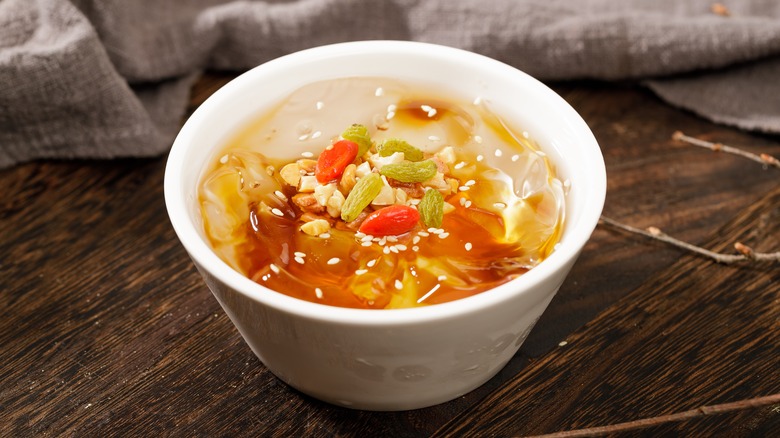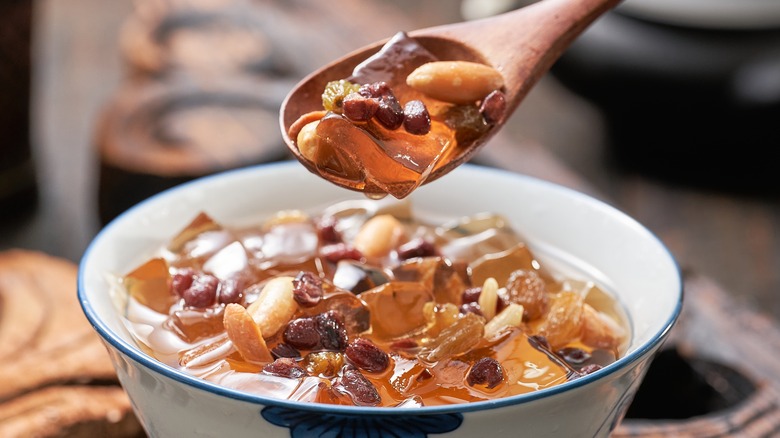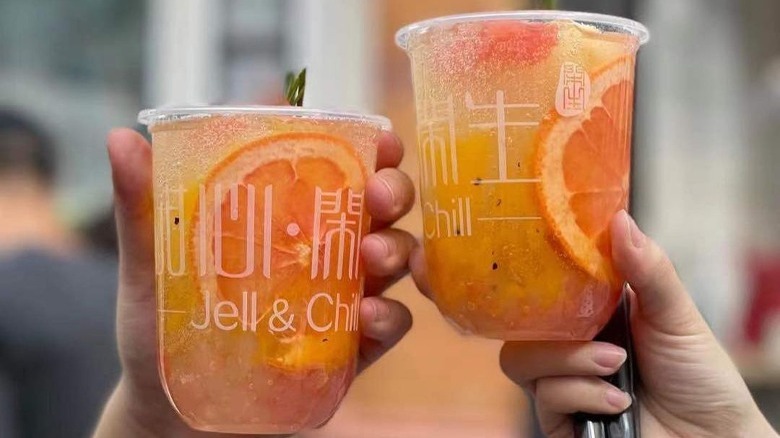Bingfen: The Chinese Ice Jelly That's Delightfully Thirst-Quenching
If you're craving something cool during the warm summer months, bingfen may just be the treat for you. The Chinese dessert — also called "ice jelly" or "crystal jelly" — has been around for over a century. It gets its jelly texture from pectin, which is scrubbed from shoofly plant seeds (Nicandra physalodes) and strained through a cloth into a bowl of mineral water with slaked lime (also called calcium hydroxide). That pectin then semi-solidifies into a jelly after resting for a few hours.
The extremely light flavor of the bingfen is refreshing and hydrating and is a summertime favorite for many. Some even say that the dish is chilled enough to cool you down from the inside out once you eat it (and it's not the only Asian jelly that cools you off). The texture isn't overwhelming, either — it's actually smooth enough to drink, similar to the jellies in bubble tea.
Because the jelly is made from the seeds of a plant, it's generally considered to be a healthier treat than other, sugar-filled alternatives.
Take the flavor up a notch with some toppings
The seeds of the shoofly plant luckily even have some health benefits, which are then translated over into the jelly. Food & Wine reports that the treat is low calorie and contains very little sugar content on its own. Some even believe that the seeds can help work as decongestants and have antioxidant properties.
Because the flavor of the jelly is so mild, it's easy to add other delicious ingredients to each serving. The base of bingfen is pretty simple, but it's the customizable toppings that really add some flair to the dish's overall flavor. The simplest version of the dish is usually sweetened up with some sugar syrup, then sprinkled with crushed peanuts.
Others might add in sesame seeds, fresh fruit, raisins, or haw flakes — a Chinese candy made from hawthorn fruit — on top of the jelly. Some even add some extra texture in the form of sweet fermented rice, rose petals, or tamarind juice for a sweet and sour punch.
The treat might be difficult to find
Because shoofly seeds are harder to find — except in China, where they're grown — the treat is rarely enjoyed outside of the country, save for a few specialty places that import the plant. Powdered shoofly seeds can be more readily found and used, though the texture of the jelly may differ slightly from the fresh version prepared with whole seeds.
A similar jelly can also be created using konjac powder, which is created from the elephant yam and is usually used to form noodles or rice. The powder creates a jelly that is similarly see-through with a very mild flavor, but it won't be identical to the airiness of traditional bingfen.
If you're craving an authentic version of the dish, it can be found being sold by plenty of Southwest Chinese street vendors, particularly in Chengdu. One company, Jell & Chill, has also brought the treat to California. Its co-owners, Yu Zhang and Zixi Zhou, both grew up in China and craved their childhood favorite after moving to the United States.
While this cool and sweet treat may not be so simple to find outside of China, the refreshing experience will make it worth the hunt.


